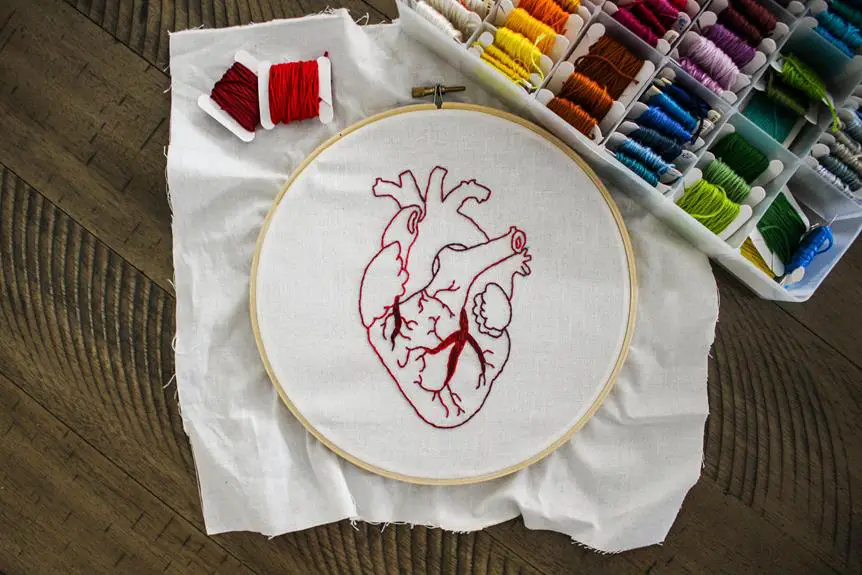If you're considering using muslin for your next embroidery project, you might be wondering if it's the best fabric choice. Muslin is often praised for its versatility and affordability, making it a popular option for many embroiderers.
In this exploration, we'll delve into the qualities of muslin for embroidery, compare it to other popular embroidery fabrics, weigh the pros and cons of using muslin, and provide tips for embroidering on this fabric.
By the end, you'll have a comprehensive understanding of whether muslin is the best fabric for your embroidery endeavors.
Key Takeaways
- Muslin is a versatile and durable fabric that provides a stable foundation for stitching.
- It is an affordable and widely available option for embroidery projects.
- Muslin is known for its durability and ability to withstand stitching without distorting.
- However, it is prone to fraying and its sheer quality may not provide desired opacity for certain designs.
The Qualities of Muslin for Embroidery
When choosing fabric for embroidery, you should consider the smooth and even weave of muslin, which provides a stable foundation for intricate stitching. Muslin fabric is favored by many embroiderers for its versatility and durability. Its tight weave prevents the embroidery threads from slipping or creating uneven tension, resulting in a neater and more professional-looking finished product.
Muslin also readily accepts different embroidery techniques, such as satin stitch, backstitch, and French knots, allowing for a wide range of creative possibilities. Additionally, muslin's light color and slightly textured surface make it easy to transfer embroidery patterns and designs. Its affordability and availability in different weights and finishes further enhance its appeal for embroidery projects of varying intricacy.
When working with muslin fabric, it's important to choose the appropriate weight and quality for the specific embroidery technique and design. Understanding the characteristics of muslin and how it interacts with different embroidery techniques will enable you to make informed decisions and achieve superior results in your embroidery endeavors.
Comparing Muslin to Other Embroidery Fabrics
You may find that muslin offers a more stable and versatile foundation for embroidery compared to many other fabrics.
When comparing muslin to other embroidery fabrics, consider the following:
- Suitability: Muslin is well-suited for various embroidery techniques, including cross-stitch, crewel, and satin stitch. Its smooth and even weave allows for intricate designs and detailed work.
- Cost: Muslin is an affordable option for embroidery projects, making it cost-effective, especially for beginners or large-scale projects.
- Availability: Muslin is widely available in fabric stores and online, offering a readily accessible option for embroidery enthusiasts.
- Versatility: Muslin's neutral color and plain weave make it a versatile choice for a wide range of embroidery styles and patterns.
- Durability: Muslin is known for its durability, providing a sturdy base for embroidery that can withstand the rigors of stitching without easily distorting or stretching.
When considering these factors, muslin emerges as a solid choice for embroidery, offering a balance of suitability, cost-effectiveness, availability, versatility, and durability.
Pros and Cons of Using Muslin for Embroidery
Although muslin is well-regarded for its suitability and affordability in embroidery, it may present some drawbacks as well.
One of the advantages of using muslin for embroidery is its smooth and even texture, which provides a great foundation for intricate stitching. The lightweight and breathable nature of muslin also makes it easy to handle and ideal for various embroidery techniques. Additionally, muslin is known for its durability, allowing the embroidery to withstand regular wear and tear.
However, there are limitations to consider when using muslin for embroidery. Its thin and delicate nature can make it more prone to fraying, especially when working on highly detailed designs. Additionally, the sheer quality of muslin may not be suitable for all embroidery projects, as it may not provide the desired opacity for certain designs.
It's important to carefully consider the specific requirements of the embroidery project to determine whether muslin is the best fabric choice.
Tips for Embroidering on Muslin Fabric
Embroidering on muslin fabric is best approached with careful consideration of the fabric's delicate nature and the specific embroidery techniques you intend to use. When embroidering on muslin, keep these tips in mind to achieve the best results:
- Choosing thread: Select embroidery thread that complements the muslin fabric. Consider using a single strand of embroidery floss for delicate and intricate designs, or multiple strands for bolder, more visible stitches.
- Hoop placement: Secure the muslin fabric tautly in an embroidery hoop to prevent puckering and ensure even stitches. Avoid pulling the fabric too tightly, as muslin is delicate and can distort easily.
- Backing fabric: For added stability, consider using a lightweight stabilizer or backing fabric when embroidering on muslin. This can help prevent puckering and distortions in the fabric.
- Needle selection: Use a sharp embroidery needle appropriate for the weight of the muslin fabric. A fine needle will create smaller punctures, minimizing damage to the delicate fibers.
- Stitching technique: Experiment with different embroidery stitches to find the ones that work best with muslin. Consider using smaller, more delicate stitches for a refined look on this lightweight fabric.
Exploring Alternative Fabrics for Embroidery
When exploring alternative fabrics for embroidery, it's important to occasionally experiment with different textures and weights to determine their compatibility with various stitching techniques.
Silk dupioni, known for its lustrous appearance and irregular slubs, is a luxurious option for embroidery, providing a unique surface for intricate needlework. Its smooth texture allows for precise stitching, making it suitable for detailed designs.
On the other hand, a linen blend offers a more rustic and textured surface, adding depth and character to embroidered pieces. Linen's natural fibers create an organic and earthy feel, which can complement certain embroidery styles, particularly those with a vintage or traditional aesthetic.
Both silk dupioni and linen blend present alternative options to muslin, each bringing its own distinctive qualities to the art of embroidery.
As you continue to explore alternative fabrics, consider the intended style and effect of your embroidery, and carefully assess how different fabrics can enhance and elevate your stitching projects.
Frequently Asked Questions
Can Muslin Fabric Be Dyed Easily for Embroidery Projects?
Yes, muslin fabric can be easily dyed for embroidery projects. Its light and absorbent nature makes it ideal for fabric dyeing, ensuring vibrant and long-lasting colors. Just be sure to follow recommended fabric care instructions.
What Are the Best Needle and Thread Types to Use When Embroidering on Muslin?
When embroidering on muslin, consider using sharp or crewel needles for fine details and smooth thread. Opt for cotton, silk, or rayon threads for a variety of textures. Experiment to find the best combination for your project.
How Does Muslin Fabric Hold up Over Time With Frequent Washing and Wearing?
With frequent washing and wearing, muslin fabric holds up well due to its durability. It also absorbs dye effectively, allowing for vibrant and long-lasting colors. Overall, muslin is a reliable choice for enduring embroidery projects.
Are There Any Specific Techniques or Stitches That Work Best on Muslin Fabric for Embroidery?
When working with muslin fabric for embroidery, it's important to consider specific embroidery techniques that complement its texture. Utilizing stitches such as the satin stitch or running stitch can yield beautiful results on muslin fabric for embroidery.
Can Muslin Fabric Be Used for Both Hand Embroidery and Machine Embroidery Projects?
Yes, muslin fabric can be used for both hand embroidery and machine embroidery projects. It's a versatile option for fabric selection, allowing for various embroidery techniques and accommodating different embroidery tools. Proper fabric care is essential for successful embroidery.



